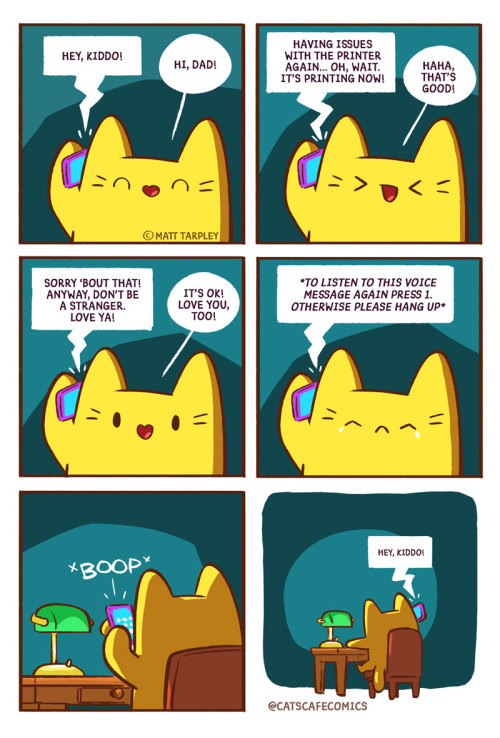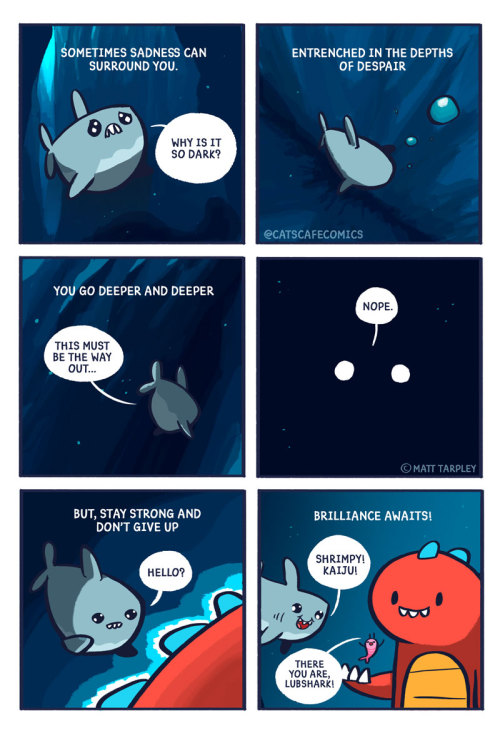-
chevron_right
Phone call
comics.movim.eu / CatsCafe · Monday, 28 June, 2021 - 14:01

Phone call
Phone call
comics.movim.eu / CatsCafe · Monday, 28 June, 2021 - 14:01

Phone call
How to Spot the Difference Between Sympathy and Empathy
pubsub.dcentralisedmedia.com / LifehackerAustralia · Wednesday, 10 February, 2021 - 20:00 · 2 minutes
The words “sympathy” and “empathy” are often used interchangeably, but while both refer to how one responds to another’s suffering, they do not mean the same thing or offer the same experience for either you or the person receiving them.
To start, here’s what Grammarly says about the history of empathy and sympathy, and how they are connected:
Of the two words, empathy is the more recent entry into the English language. Sympathy was in use for almost 300 years before empathy ’s first written record in the nineteenth century. You might notice that both words contain -pathy , and that’s what makes them sort of similar–they share the same Greek root word pathos , which means “feelings” or “emotion,” but also “suffering” or “calamity.” But while both words deal with emotions, they are still very far from being synonyms.
Empathy is the capacity to be able to imagine oneself in someone else’s situation, either because you have experienced something similar or because you can understand their feelings to a depth with which it feels as though you’re having them yourself. To be empathetic is to create a shared experience with another person.
Empathy tends to look like someone who really listens, and it can sound like, “That must be so difficult,” and “How are you feeling?” A Kids Book About Empathy (by Daron K. Roberts) explains it in a way both adults and kids can understand:
It’s when you feel with someone who is experiencing something that’s hard, sad, or scary. Empathy means you listen, don’t judge, feel with, and ask questions.
In other words, to empathise is to experience another’s emotion . It is feeling with someone.
Sympathy is less about experiencing the emotions of another person and more about feeling and expressing your concern, pity, or sorrow over their pain or misfortune. “Sympathy cards,” therefore, are aptly named because they provide a way to you to voice the sadness you feel for their experience.
When someone sympathizes, they feel bad about what someone else is going through without fully walking the emotional journey with them. Sympathy sounds like, “I’m sorry,” or “That really sucks.”
In other words, to sympathise is to commiserate with the struggle another is experiencing . It is feeling for someone.
The post How to Spot the Difference Between Sympathy and Empathy appeared first on Lifehacker Australia .
Use These 3 Skills to Increase Your Emotional Agility
pubsub.dcentralisedmedia.com / LifehackerAustralia · Sunday, 7 February, 2021 - 20:52 · 3 minutes
If you’ve found yourself having an overblown reaction to something relatively small during the past year or so, you’re not alone. We’re all juggling so much — mentally and emotionally — that it can be difficult to continuously have to process everything that comes our way. These can be anything from major threats — like the global pandemic, racial injustice and violence, and economic/financial insecurity — to your average everyday annoyances.
When faced with so much at one time, it’s easy to have big, emotional reactions to everything, even the smaller stuff. One way to help deal with this is by strengthening your emotional agility. Here are three tips for doing that.
If you haven’t heard of “emotional agility” before, that may be because it has only been around since 2013, when leadership coaches Dr. Susan David and Christina Congleton first coined the term in a Harvard Business Review article . Basically, emotional agility is exactly what it sounds like: having the ability and skills necessary to think problems and emotions that come up through during periods of complexity and change.
As David explained in a recent episode of the Armchair Expert podcast , there are three key skills you can practice to improve your emotional agility in uncertain times: acceptance, compassion and curiosity. Here are some ways to improve each of those crucial skills, according to Vanessa Loder, a former Wall Street and Silicon Valley executive, now working as a mindfulness consultant.
According to Loder in an article for MindBodyGreen , emotional agility begins with recognising that you are not your feelings. She writes :
Labelling your thoughts and feelings is a powerful way to begin accepting what you are feeling without being overtaken by it. When you say, “I am sad,” you become fused with sadness. It is now your identity. You are the grey cloud of sadness. When you say; “I notice that I’m feeling sadness,” now you are more the observer. You are the sky. The grey cloud of sadness is simply passing through.
Now that you’ve identified how you’re feeling, approach the emotions with compassion. Per Loder :
When you label your emotions more accurately, you can better understand the cause of that emotion and what you can be doing in relation to that emotion. If underneath your stress is loneliness, perhaps you are craving more intimacy and connection so it’s important to reach out and call a friend. On the other hand, if behind your stress is disappointment, maybe it’s time to have a difficult conversation with your boss or express your disappointment to someone.
Get curious about why your emotions are causing a specific reaction. Loder says that the next time you are processing a difficult emotion, ask yourself “What is this emotion trying to tell me that is important to me right now?” She goes on to explain :
If your emotion is telling you that you’re upset with your boss or colleague, it doesn’t mean you need to tell off your boss or suppress your anger and put on a happy face. As David says, “Emotions are data, not directives.” Instead, ask what can bring you closer to creating the career and life you love? Get curious about what value that emotion is pointing you toward. That is the power of our emotions; they are guideposts to our deeper truth.
Thanks to the pandemic and other global factors, 2020 has been a rough year for people with anxiety — whether they had an existing diagnosis, or are experiencing that unwanted feeling (and its many side effects) for the first time. A lot of that stems from all the uncertainty we’ve...
Read moreYes, these strategies do take some time and practice, because let’s face it: it may seem much easier to have a generic Big Feelings reaction to everything and let it get us worked up, but really, we’re only adding additional stress to our plate when we do that.
The post Use These 3 Skills to Increase Your Emotional Agility appeared first on Lifehacker Australia .
LubSad
comics.movim.eu / CatsCafe · Tuesday, 6 October, 2020 - 14:00

LubSad